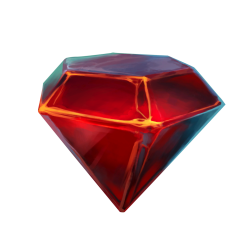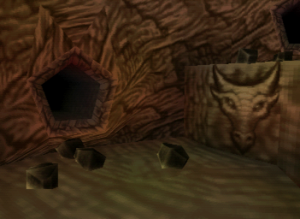Dragon Gem: Difference between revisions
DansFriend (talk | contribs) No edit summary |
DansFriend (talk | contribs) |
||
| Line 47: | Line 47: | ||
===In real life=== | ===In real life=== | ||
In Chapter 57 of Book 37: "The Natural History of Precious Stones" in [[wikipedia:Pliny the Elder|Pliny the Elder]]'s ''[[wikipedia:Natural History (Pliny)|The Natural History]]'', draconitis (meaning '''Dragon Stone''') or [[wiktionary:Dracontia|dracontia]] is said to be "a stone produced from the brain of the dragon; but unless the head of the animal is cut off while it is alive, the stone will not assume the form of a gem, through spite on the part of the serpent, when finding itself at the point of death: hence it is that, for this purpose, the head is cut off when it is asleep."<ref>{{Cite web|title=The Project Gutenberg eBook of The Natural History of Pliny, Volume 6 (of 6)|site=Project Gutenberg|url=https://www.gutenberg.org/cache/epub/62704/pg62704-images.html|published=July 19, 2020|retrieved=July 5, 2023}}</ref> | In Chapter 57 of Book 37: "The Natural History of Precious Stones" in [[wikipedia:Pliny the Elder|Pliny the Elder]]'s ''[[wikipedia:Natural History (Pliny)|The Natural History]]'', draconitis (meaning '''Dragon Stone''') or [[wiktionary:Dracontia|dracontia]] is said to be "a stone produced from the brain of the dragon; but unless the head of the animal is cut off while it is alive, the stone will not assume the form of a gem, through spite on the part of the serpent, when finding itself at the point of death: hence it is that, for this purpose, the head is cut off when it is asleep."<ref>{{Cite web|title=The Project Gutenberg eBook of The Natural History of Pliny, Volume 6 (of 6)|site=Project Gutenberg|url=https://www.gutenberg.org/cache/epub/62704/pg62704-images.html|published=July 19, 2020|retrieved=July 5, 2023}}</ref> | ||
==Gallery== | |||
{{Main|:Category:Images of Dragon Gems|l1=Images of Dragon Gems}} | |||
<gallery> | |||
File:MediEvil1998-PumpkinSerpentDragonGem.png|The Dragon Gem in The Pumpkin Serpent. | |||
File:MediEvil1998-InsideTheAsylumDragonGem.png|The Dragon Gem inside The Asylum. | |||
</gallery> | |||
==In other languages== | ==In other languages== | ||
Revision as of 01:53, 6 July 2023
| Dragon Gem | ||
|---|---|---|
 | ||
| Icon | ||
| Flavour text | A sight for sore dragon eyes. | |
| Type | Item | |
| Requirement(s) | Witch Talisman | |
| Found in | The Pumpkin Serpent Inside The Asylum | |
| Given by | Pumpkin Witch Town Mayor | |
| Used in | The Crystal Caves | |
| Appears in | MediEvil (1998) MediEvil (2019) | |
|
Dragon Gems were precious jewels that could summon Dragons. Two such gems could be found in Gallowmere in the late 14th century.
History
By 1386, a Dragon Gem was in the possession of the Pumpkin Witch Wartilda and another was owned by Zarok the Sorcerer. The Pumpkin Witch gave her gem to Sir Dan as a reward for defeating the Pumpkin King. Zarok left his gem in the Town Mayor's cell inside the Asylum, who was happy for Dan to take it.
Subsequently, Dan used both gems to summon the Dragon in the Crystal Caves.
Characteristics
Appearance
The gems were red, hexagonal (or pentagonal according to some), table cut precious stones, shaped to fit into the eye sockets of a dragon's head relief in the Crystal Caves.
Gameplay
Overview
|
The two Dragon Gems are required in order to progress past the Dragon Gate in the Gallows Gauntlet; at least without abusing glitches. The Dragon Armour needed to get past the gate is obtained by defeating the Dragon, who can only be summoned using the gems.
To collect the gem owned by the Pumpkin Witch, Dan needs to have the Witch Talisman from Cemetery Hill. Without it, it is impossible to summon the witch. The witch has to be spoken to after the Pumpkin King has been defeated to claim the gem.
Obtaining the gem from inside the Asylum is more straightforward as it has no prerequisites; Dan simply needs to reach the final room with the Town Mayor's cell.
After the Dragon Gems are used and the Dragon has been defeated they cannot be reobtained by replaying the levels.
MediEvil (2019 remake)
Loading screen hint
|
Behind the scenes
Development
MediEvil (1998 original)
The gems were a later addition to the game as they did not exist in early versions like the MediEvil Rolling Demo or the MediEvil ECTS Pre-Alpha.
An unused book in The Sleeping Village would have explained how the Town Mayor acquired a Dragon Gem:
|
The book was likely removed because, in the final game, the Town Mayor's dialogue implies that the gem was left behind by Zarok:
|
The holes the Dragon comes out of during the boss fight seem to be shaped like the top of the gems.
MediEvil (2019 remake)
The gems were changed from having a pentagonal shape to a hexagonal shape. The inventory icon for the gems was also changed from a top view to a side view.
In real life
In Chapter 57 of Book 37: "The Natural History of Precious Stones" in Pliny the Elder's The Natural History, draconitis (meaning Dragon Stone) or dracontia is said to be "a stone produced from the brain of the dragon; but unless the head of the animal is cut off while it is alive, the stone will not assume the form of a gem, through spite on the part of the serpent, when finding itself at the point of death: hence it is that, for this purpose, the head is cut off when it is asleep."[1]
Gallery
- Main article: Images of Dragon Gems
In other languages
| Language | Name | Meaning |
|---|---|---|
| Arabic | جوهرة التنين jawharat altiniyn |
- |
| Bulgarian | Драконов скъпоценен камък Drakonov skŭpotsenen kamŭk |
- |
| Croatian | Zmajev dragulj | - |
| Czech | Dračí drahokam | - |
| Danish | Dragesten | Dragonstone |
| Dutch | Drakensteen | - |
| Finnish | Lohikäärmekivi | Dragonstone |
| French (France) | Pierre de Dragon | Dragon Stone |
| German | Drachenedelstein | - |
| Greek | Πετράδι του Δράκου Petrádi tou Drákou |
Dragonstone |
| Hungarian | Sárkánykámea | Dragon Cameo |
| Italian | Gemma di Drago | - |
| Japanese | ドラゴンの宝石 Doragon no hōseki |
- |
| Norwegian | Dragekrystall | Dragon Crystal |
| Polish | Smoczy klejnot | - |
| Portuguese (Brazil) | Gema de Dragão | - |
| Portuguese (Portugal) | Pedra de Dragão | Dragon Stone |
| Romanian | Nestemata Dragonului | - |
| Russian | Драконий самоцвет Drakoniy samotsvet |
- |
| Spanish (LatAm) | Gema dragón | - |
| Spanish (Spain) | Gema de dragón | - |
| Swedish | Drakjuvel | - |
| Turkish | Ejderha Taşı | Dragon Stone |
References
- ↑ The Project Gutenberg eBook of The Natural History of Pliny, Volume 6 (of 6) on Project Gutenberg. Published July 19, 2020. Retrieved July 5, 2023.


